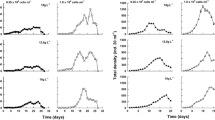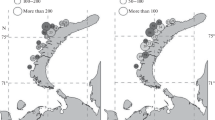Abstract
Populations of two chitons, Onithochiton quercinus (Gould, 1846) and Plaxiphora albida (Blainville, 1825) were sampled at five sites in the low-shore algal community at Cape Banks, New South Wales, Australia, from January 1985 to February 1988. Both species were abundant, reaching densities of 96 and 45 m-2, respectively and grew to 80 mm in length. O. quercinus and P. albida were found on the solitary ascidian Pyura stolonifera and on the substratum in amongst the foliose macroalgae which dominate this community. Size-frequency data were used to estimate the rates of growth, mortality and longevity, and time of recruitment. Growth of both species was rapid for the first 3 yr and slowed thereafter. O. quercinus and Plaxiphora albida had similar longevities and were estimated to live for at least 6 yr. Reproductive samples were also collected to identify when sexual maturity occurred, to clarify the reproductive periodicity, and to examine the sex ratios of the two species. Both species spawned over a discrete period in early autumn and there was no evidence of the bi-annual spawning reported in a previous study. Recruitment of O. quercinus and P. albida occurred during autumn, but recruits could not be quantified owing to their cryptic nature. The microhabitats occupied by the recruits of both species included the empty shells of the barnacle Austromegabalanus nigrescens, the spaces between the calcareous tubes of the polychaete Galeolaria caespitosa, and the space amongst the algae on Pyura stolonifera. Both species reached reproductive maturity at 2 yr of age. The sex ratios of both species were consistent with the results of a previous study: P. quercinus had a sex ratio of almost 2:1 biased in favour of males, and Plaxiphora albida exhibited a sex ratio of 1:1. The study suggested that populations of O. quercinus and P. albida could persist in the low-shore algal community in the absence of recruitment. This, together with their large size and consumption of macroalgae suggests that they have the potential to affect the structure and dynamics of this intertidal community.
Similar content being viewed by others
References
Ashby E (1926) The regional distribution of Australian chitons (Polyplacophora). Rep Australas Ass Advmt Sci 17:366–393
Barnes JR, Gonor JJ (1973) The larval settling response of the lined chiton Tonicella lineata. Mar Biol 20:259–264
Baxter JM, Jones AM (1978) Growth and population structure of Lepidochitona cinereus (Mollusca: Polyplacophora) infected with Minichinia chitonis (Protozoa: Sporozoa) at Easthaven, Scotland. Mar Biol 46:305–313
Boolootian RA (1964) On growth, feeding and reproduction in the chiton Mopolia mucosa in Santa Monica Bay. Helgoländer wiss Meersunters 11:186–199
Branch GM (1981) The biology of limpets: physical factors, energy flow and ecological interactions. Oceanogr mar Biol A Rev 19:235–380
Cassie RM (1954) Some uses of probability paper in the analysis of size-frequency distributions. Aust J mar Freshwater Res 5:513–522
Christiansen ME (1954) The life history of Lepidopleurus asellus (Spengler) (Polyplacophora) Nytt Mag Zool 2:52–72
Connell JH (1975) Some mechanisms producing structure in natural communities: a model and evidence from field experiments. In: Cody MI, Diamond JM (eds) Ecology and evolution of communities. Harvard University Press, Cambridge, pp 460–490
Creese RG (1980) Reproductive cycles and fecundities of four common eastern. Australian archaeogastropod limpets (Mollusca: Gastropoda). Aust J mar Freshwat Res 31:49–59
Creese RG (1981) Patterns of growth, longevity and recruitment of recruitment of intertidal limpets in New South Wales. J exp mar Biol Ecol 51:145–171
Creese RG (1986) Brooding behaviour and larval development in the New Zealand chiton, Onithochiton neglectus de Rochebrune (Mollusca: Polyplacophora). NZ J Zool 13:83–91
Crozier WJ (1918) Growth and duration of life of Chiton tuberculatus. Proc natn Acad Sci USA 4:322–325
Cruz RA, Sotela A (1984) Contributions to the biology of Chiton stockesii (Polyplacophora: Chitonidae) of Punta Pochote, Puntarenas, Costa Rica. Revta Biol trop 32:61–68
Currie DR (1990) Reproductive periodicity of three species of chitons at a site in New South Wales, Australia (Mollusca: Polyplacophora). Invert Reprod Dev 17:25–32
Dakin WJ (1952) Australian seashores. Angus & Robertson, Sydney
Dall WH (1919) New species of chitons from the Pacific coast of America Proc US natn Mus 55:499–516
Dayton PK (1971) Competition, disturbance and community organisation: the provision and subsequent utilization of space in a rocky intertidal community. Ecol Monogr 41:351–389
Dayton PK, Rosenthal RJ, Mahen LC, Antezana T (1977) Population structure and foraging biology of the predaceous Chilean asteroid Meyenaster gelatinosus and the escape biology of its prey. Mar Biol 39:361–370
Duggins DO, Dethier MN (1985) Experimental studies of herbivory and algal competition in a low intertidal habitat. Oecologia 67:183–191
Elton C (1927) Animal ecology. Sidgwick & Jackson, London
Giese AC, Tucker JS, Boolootian RA (1959) Annual reproductive crystal of the chitons, Katharina tunicata and Mopalia hindsii. Biol Bull mar biol Lab, Woods Hole 17:81–88
Glynn PW (1970) On the ecology of the Carribean chitons Acanthopleura granulata Gmelin and Chiton tuberculatus Linne: density, mortality, feeding reproduction, and growth. Smithson Contr Zool 66:1–21
Grave BH (1932) Embryology and life history of Chaetopleura apiculata. J Morph 54:152–160
Heath H (1905) The breeding habits of the chitons of the California coast. Zool Anz 29:390–393
Himmelman JH (1975) Phytoplankton as a stimulus for spawning in three marine invertebrates. J exp mar Biol Ecol 20:199–214
Himmelman JH (1978) The reproductive cycle of Katharina tunicata Woods and its controlling factors. J exp mar Biol Ecol 31:27–41
Huyer A, Smith RL, Stabeno PJ, Church JA, White NJ (1988) Currents off south-eastern Australia: results from the Australian coastal experiment. Aust J mar Freshwat Res 39:245–288
Iredale T, Hull AFB (1927) A monograph of the Australian loricates (phylum Mollusca-order Loricata). Proc R zool Soc NSW, 1–168
Irons DB, Anthony RG, Estes JA (1986) Foraging strategies of glaucous-winged gulls in a rocky intertidal community. Ecology 67:1460–1474
Kangas M, Shepherd SA (1984) Distribution and feeding of chitons in a boulder habitat at West Island, South Australia. J malac Soc Aust 6:101–111
MacGinitie GE, MacGinitie N (1968) Notes on Cryptochiton stelleri (Middendorff, 1846). Veliger 11:59–61
Morton JE, Miller MC (1973) The New Zealand sea shore. Collins, London
Nagabhushanam R, Deshpande UD (1982) Reproductive cycle of the chiton Chiton iatricus and environmental control of its gonad growth. Mar Biol 67:9–13
Otaiza RD, Santelices B (1985) Vertical distribution of chitons (Mollusca: Polyplacophora) in the rocky intertidal zone of central Chile. J exp mar Biol Ecol 86:229–240
Otway NM (1994) The low-shore algal community in New South Wales: spatial and temporal patterns of abundance and the effects of removing solitary ascidians. Aust J Ecol (in press)
Paine RT (1966) Food web complexity and species diversity. Am Nat 100:65–75
Paine RT (1974) Intertidal community structure — experimental studies on the relationship between a dominant competitor and its principal predator. Oecologia 15:93–120
Paine RT (1984) Ecological determinism in the competition for space. Ecology 65:1339–1348
Pearse JS (1978) Reproductive periodicities of Indo-Pacific invertebrates in the Gulf of Suez. IV. The chitons Acanthopleura haddoni Winckworth and Onithochiton lyelli (Sowerby), and the abalone Haliotis pustulata Reeve. Bull mar Sci 28:92–101
Pearse JS (1979) Polyplacophora. In: Giese AC, Pearse JS (eds) Reproduction of marine invertebrates. Vol. V. Molluscs: pelecypods and lesser classes. Academic Press, New York, pp 27–85
Piercy RD (1987) Habitat and food preferences in six Eastern Pacific chiton species (Mollusca: Polyplacophora). Veliger 29:388–393
Pope EC (1943) Animal and plant communities of the coastal rockplatform at Long Reef, New South Wales. Proc Linn Soc NSW 68:221–254
Randall JE (1967) Food habits of reef fishes of the West Indies. Stud trop Oceanogr 5:665–847
Randall CW, Martin RF (1987) Distribution, abundance and movement patterns of shoreline chitons of the Carribean coast of Mexico. Nautilus 101:75–79
Reimer AA (1976) Description of a Tetraclita stalactifera panamensis community on a rocky intertidal shore of Panama. Mar Biol 35:225–238
Ryan TA (1960) Significance tests for multiple comparisons of proportions, variances and other statistics. Psychol Bull 88:354–355
Sakker ER (1984) Sperm morphology, spermatogenesis and spermiogenesis of three species of chitons (Mollusca, Polyplacophora). Zoomorphology 104:111–121
Sakker ER (1986) Seasonal reproductive cycles of three Australian species of chitons (Mollusca: Polyplacophora). Int J Invert Reprod Dev 10:1–16
Selwood L (1968) Interrelationships between developing oocytes and ovarian tissues in the chiton Sypharochiton septentriones (Ashby) (Mollusca, Polyplacophora). J Morph 125:71–103
Simpson RD (1976) Physical and biotic factors limiting the distribution and abundance of littoral molluscs on Macquarie Island (sub-Antarctic). J exp mar Biol Ecol 21:11–49
Smith AG (1966) The larval development of chitons (Amphineura). Proc Calif Acad Sci 32:433–466
Snedecor GW, Cochran WG (1980) Statistical methods. 7th ed. Iowa State University Press, Ames, Iowa
Stephenson TA, Stephenson A (1972) Life between tidemarks on rocky shores. WH Freeman, San Francisco
Trenamen N, Short AD (1987) Deepwater and breaker wave climate of the Sydney region New South Wales 1971–1985. Department of Geography, University of Sydney, NSW, Australia (Coastal Studies Unit Tech Rep No. 87/1)
Underwood AJ (1975) Comparative studies on the biology of Nerita atramentosa Reeve, Bembicium nanum (Lamarck) and Cellana tramoserica (Sowerby) (Gastropoda: Prosobranchia) in SE Australia. J exp mar Biol Ecol 18:153–172
Underwood AJ (1979) The ecology of intertidal gastropods. Adv mar Biol 16:111–210
Underwood AJ (1981) Techniques of analysis of variance in experimental marine biology and ecology. Oceanogr mar Biol Rev 19:513–605
Underwood AJ, Jernakoff P (1981) Effects of interactions between algae and grazing gastropods on the structure of a low shore intertidal algal community. Oecologia 48:221–233
Underwood AJ, Kennelly SJ (1990) Ecology of marine algae on rocky shores and subtidal reefs in temperate Australia. Hydrobiologia 192:3–20
Watanabe JM, Cox LR (1975) Spawning behaviour and larval development of Mopalia lignosa and Mopalia muscosa (Mollusca: Polyplacophora) in central California. Veliger 18 (Suppl.): 18–27
Wells FE, Sellers RJ (1987) Reproductive periodicity of the chiton Acanthopleura hirtosa on intertidal platforms in the Perth area. J malac Soc Aust 8:87–92
Yoshioka E (1987) Annual reproductive cycle of the chiton Acanthopleura japonica. Mar Biol 96:371–374
Author information
Authors and Affiliations
Additional information
Communicated by G. F. Humphrey, Sydney
Rights and permissions
About this article
Cite this article
Otway, N.M. Population ecology of the low-shore chitons Onithochiton quercinus and Plaxiphora albida . Marine Biology 121, 105–116 (1994). https://doi.org/10.1007/BF00349479
Received:
Accepted:
Issue Date:
DOI: https://doi.org/10.1007/BF00349479




